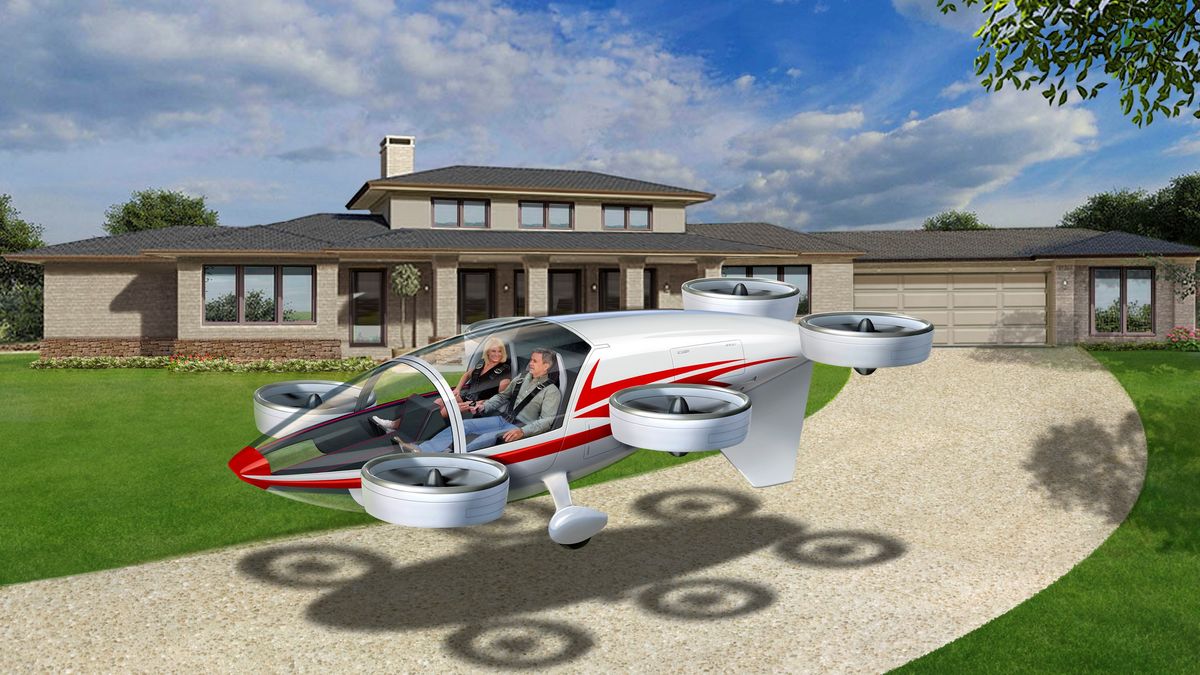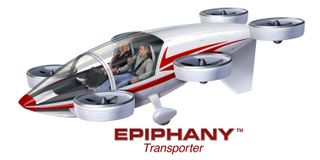NASA propulsion technology brings 'flying cars' closer to reality
Will the Epiphany Transporter finally bring us the flying taxis of the future?

Flying cars could finally actually be on the horizon.
Anyone who's seen "Blade Runner" or "The Jetsons" knows that you can't have "The Future" without flying cars, but despite many people's hopes, these flying personal transports have always seemed to be one step ahead of the present. Now, one company is coming out to say that it has the key to making these fantastic fly machines a reality, and it has a NASA-proven propulsion system at its heart that makes it hard to dismiss as easily.
The company, Applied eVTOL Concepts, presented its plan for the Epiphany Transporter this week, a vertical take-off and landing (VTOL) vehicle that the company said is capable of a top speed of 160 mph (258 kph) but generates less than 55 decibels of noise at 50 feet (15 meters) up, which is somewhere between the volume of a steady rainfall (50 dB) and normal human conversation (60 dB).
Related: NASA and Uber are getting serious about flying cars
The secret appears to be the ducted thrusters along the sides and rear of the Epiphany Transporter, which researchers at NASA's Ames Research Center found in 2002 proved to produce a significant amount of thrust, the physical force that powers jet engines and helicopters.
The ducted design also has the added advantage of shielding the spinning blades inside the duct that are generating the thrust, and Rob Bulaga, the project engineer for the Epiphany Transporter at Applied eVTOL Concepts, was a co-author on the original paper. The design has been refined over the two decades since it was first tested at Ames, and the founder of Applied eVTOL Concepts, Michael Moshier, believes that they have advanced the technology considerably since that initial proof of concept work in NASA's wind tunnel.

"We have every reason to believe in the ability of our proprietary, field-proven ducted thrusters, and leading-edge vehicle design, to perform in flight as expected," Moshier, who is also the CEO and lead designer for the company, said in a statement.
Get the Space.com Newsletter
Breaking space news, the latest updates on rocket launches, skywatching events and more!
The craft is designed to seat two passengers and their luggage. The company says the Epiphany is about the size of a Tesla Model S, and that it could fit in your typical one-car garage.
Of course, just because the company's ducted thruster was successful in a wind tunnel doesn't mean that we're about to have flying cars any day now. A lot of VTOL companies have come and gone over the years, and there were bound to be some NASA engineers in that mix as well.
Still, working from a proven design as a foundation is always sound engineering practice, so maybe this will turn out to be the real deal after all, at long last.
Join our Space Forums to keep talking space on the latest missions, night sky and more! And if you have a news tip, correction or comment, let us know at: community@space.com.
John is a science and technology journalist and Space.com contributor. He received his B.A. in English and his M.A. in Computer Science from the City University of New York, Brooklyn College, and has bylines with TechRadar, Live Science, GamesRadar, and other publications. You can find him on Bluesky at @johnloeffler.bsky.social or seeking out dark sky country for spectacular views of the cosmos.
-
AndyTake2 Just needs a battery the size of an articulated lorry, but still...:)Reply
Aside from the power problems, the biggest issues with flying cars will be:
1: Infrastructure. One or two of these flying around is no issue, but lots of them will mean creating lots of air corridors that need to be kept clear. They will also be utterly useless for anything other than a carefully thought out destination and route. Fancy stopping off for a burger? better alert air traffic control ;)
Of course, they could use roads as a guide.
Anyone fancy lots of these flying over their heads?
Which brings us to:
2: People. there are enough morons on the roads. Does anyone really want them getting in an aircraft??
That brings us to autonomy - which would also mean that those carefully planned routes would be ok, as long as the wetware sits firmly in the passenger seat and has it's hands taped to the seat. -
Unclear Engineer Think of roadside litter, but spread everywhere, like rain.Reply
Also, think about traffic jams in 3D.
This isn't something that could be licensed the same as automobiles, even for "autonomous" flight control between destinations. People do too many stupid things in automobiles, already. There is even some stupid stuff being done by licensed pilots.
But, the mental model for "flying cars" in the minds of everyday folks is probably what they already do with cheap drones - which is pretty much the wild west, violating altitude restrictions, airspace boundaries, etc., not to mention the personal privacy of neighbors.
Its like a lot of things - I want one, but I don't want everybody else to have one. :eek: -
billslugg I believe flying cars will need to be autopiloted unless in remote areas. There is no way a manually air traffic network could deal with everyone in flying cars.Reply
Current air traffic in US is 45,000 flights per day.
Current automobile traffic is 1,100,000,000 trips per day.
ATC traffic would increase by a factor of 25,000. -
Unclear Engineer In theory, the software currently used (and being improved) for satellite constellations and drone "swarm" performances could be adapted to flying car traffic control.Reply
But, given how people tend to use cars, particularly their illegal uses of cars, makes me think that such software would not be able to safely handle the effects of people flying hacked flying cars outside the control network.
But, people will hack some of them if they can get their hands on them - and then use them to joy ride, rob banks, etc., once they become available. Heck, I recently read a story about a guy who stole a car and did several hit-and-runs before disabling the car and escaping on foot, only to stick around and steal an ambulance responding to one of his hit-and-run victims, then going on another spree of additional hit-and-runs with the ambulance. Not looking forward to that in 3D. -
Classical Motion The only except-able fuel and power for that craft right now is......kerosene.Reply
Like the flying solders do. With their hand and leg turbines. -
Classical Motion Could you imagine the horrible noise and droning at a gas station? And all the noise from overhead? So in the future, not only a dark location will be impossible to find, but a quiet location too.Reply
I don't know about you, but the noise from a drone kills the hobby and pleasure for me. And those are electric. I'll bet those kerosene turbines scream.
And when are we gona see those flying soldiers on a real mission?
Could they really surprise a hijacked tanker? How easy would they be to hit while flying?
Could a flying soldier catch a flying Cessna? Or a flying orb?
Personally I like the idea of a flying chariot, like the WASP project. I believe this to have much more promise.












